Angel Wing Begonia (Begonia coccinea x Begonia aconitifolia): Flowers, Leaves – Care Guide (Pictures)
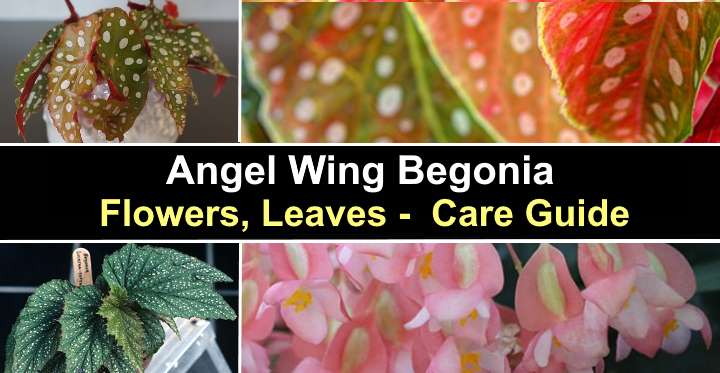
Angel wing begonia is a type of tender perennial cane begonia, famous for its beautiful spotted wing-like, pointed leaves. Not only is its foliage spectacular, but an angel wing begonia also produces clusters of drooping pink and white, red, or orange flowers. As a popular outdoor garden plant or tropical houseplant, angel wing begonia is incredibly easy to grow. Outdoors, partial-shade is ideal for this carefree plant. However, growing indoors, the begonia thrives in bright, indirect light.
The angel wing begonias upright, cane-like stems, wing-shaped leaves, and mounding evergreen foliage grow well in borders, container gardens, or shady landscapes. In addition, Angel wing begonias are ideal plants for hanging baskets and for planting in containers. The begonia’s ornamental elongated triangular leaves with speckled and spotted patterns look stunning with the flowers dangling over the side.
This article is a complete guide to caring for an angel wing begonia. After reading this article, you will know how to grow this tender perennial foliage plant in a tropical garden. If you live in temperate climates, you’ll get helpful tips on successfully growing angel wing begonia houseplants.
How to Care for Angel Wing Begonia
To grow angel wing begonia, plant it in the ground where there is loamy, fertile, well-drained soil that is constantly moist. Mulch can help keep the ground moist in winter. The angel wing begonia performs best in partial-shade. Ensure outdoor temperatures are consistently above 55°F (13°C).
In temperate climates, bring angel wing begonias indoors to overwinter them and protect them from cold and freezing conditions. Care for indoor angel begonias as you would grow any type of tropical houseplant.
Facts About Angel Wing Begonia (Begonia coccinea x Begonia aconitifolia)
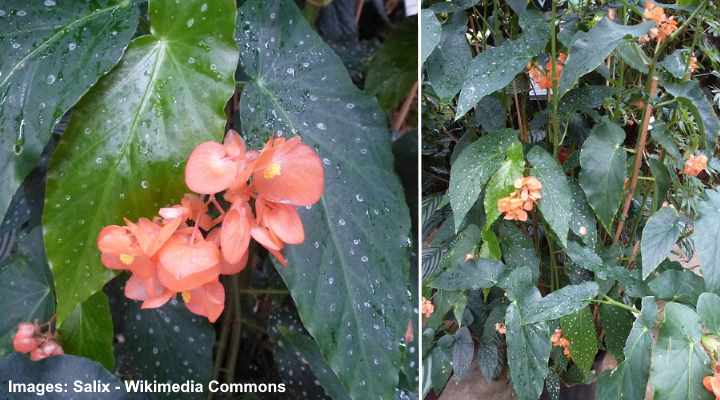
Angel wing begonia is a type of cane begonia that cannot withstand cold temperatures
Angel wing begonia has the botanical name Begonia coccinea x Begonia aconitifolia and belongs to the family Begoniaceae. The name “cane begonia” comes from the fact that this evergreen perennial plant has thick, upright stems. Like all types of cane begonias, the angel wing hybrid is a fast-growing plant with decorative triangular, or pointed leaves.
Ornamental angel wing begonias are a hybrid of two begonia species—Begonia coccinea and Begonia aconitifolia.
Begonia coccinea—also called scarlet begonia or coral begonia—has cane-like stems, oblong or ovate broad leaves, many of which have silvery spots or speckles. The Begonia coccinea also has pendulous coral-red or pink flower clusters dangling from red stalks that bloom during summer.
Begonia aconitifolia—also called metallica begonia or holly-leaf begonia—has lobed leaves with toothed margins and sunken veins. Like the angel wing begonia, silvery speckles decorate the green leaves that grow on red stems. In addition, the Begonia aconitifolia has beautiful drooping pinkish-white flower clusters.
Although angel leaf begonia is an evergreen perennial, it can’t withstand cold temperatures and is treated as an annual in cold winter regions. Therefore, like species of wax begonias, the angel wing begonia needs to be brought indoors from late fall until the risk of frost has passed in spring. However, angel wing begonias are just as easy to grow as wax begonias.
Angel wing begonias grow in various sizes, ranging from 1 ft. to 5 ft. (0.3 – 1.5 m) tall. Typically, angel wing begonias grow taller in the ground in garden landscapes. Angel wing begonia houseplants usually grow 12” to 20” (30 – 50 cm) tall and up to 24” (60 cm) wide. However, pruning helps to control the plant’s growth.
Angel Wing Begonia Flowers
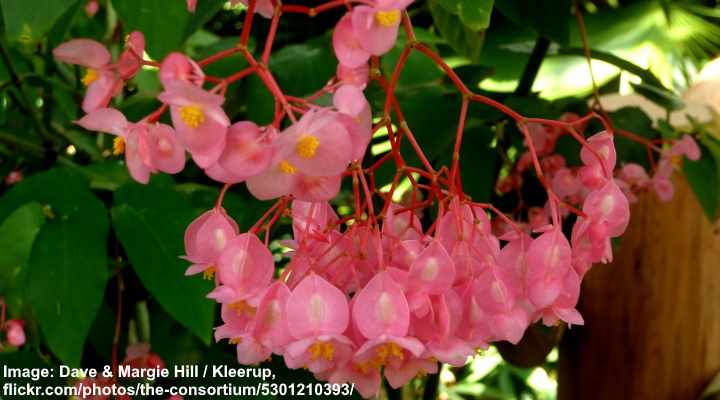
Angel wing begonia ‘Pink Shasta’
Angel wing begonia flowers are small, colorful waxy-type flowers growing in large dangling clusters. The masses of drooping flowers are typically pink, red, or orange. Small yellow stamens contrast nicely with the pinkish flowers. Another feature of angel wing begonia flowers is their sturdy red stems.
When Does Angel Wing Begonia Bloom
Angel wing begonias bloom during summer until the end of August. Under ideal conditions, angel wing begonia plants are heavy bloomers and produce flowers that almost cover the showy speckled foliage. Deadheading is an excellent way to encourage begonia flowers to continue blooming for longer.
Under ideal conditions indoors, angel wing begonia can bloom multiple times a year. Other Begonia coccinea x Begonia aconitifolia indoor plants bloom in late winter and spring.
Angel Wing Begonia Leaves
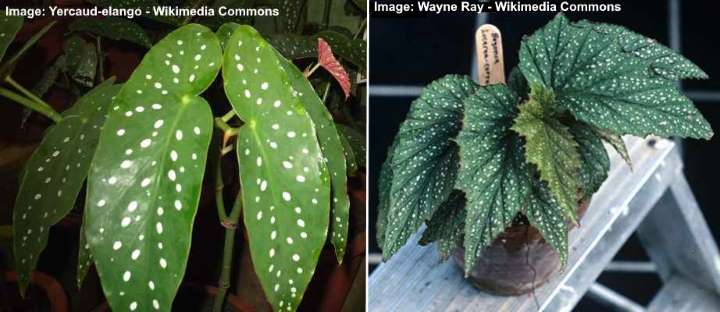
Angel wing begonia leaves
Angel wing begonia leaves are wing-shaped leaves growing on thick upright stems. The pointed, triangular leaves with frosted patterns typically have a red underside. Depending on the species, patterns on angel wing begonia leaves can be spotted or speckled. The begonia leaves grow up to 6” (16 cm) long.
Compared to other types of begonias, the leaves of angel wing begonias look like polka dot begonias (Begonia maculata).
Angel Wing Begonia Cold Tolerance
Angel wing begonia thrives in gardens in USDA zones 10 and 11. The clumping, upright, bushy angel wing begonia plant performs best in partly-shaded conditions. You can grow cane begonias in full sun, but it’s vital to keep the ground consistently moist. The minimum temperature for angel wing begonias outdoors and indoors is 55°F (13°C).
Angel Wing Begonia Varieties
There are thousands of begonia varieties and dozens of angel wing begonia hybrids to choose from. The names of the most popular angel wing begonias typically refer to the colors of blooms or leaf patterns. Some outstanding Begonia coccinea x Begonia aconitifolia hybrids include ‘Peach Parfait,’ ‘Ruby Tuesday,’ Silvermist,’ ‘Apricot Shades,’ and ‘Super Cascade.’
How to Prune Angel Wing Begonia
Pruning angel wing begonias ensures compact, bushy growth and prolific blooming. To prune the cane begonia, cut back leggy stems to about two-thirds of their length and cut just above the node. You can also pinch off growing tips to encourage the begonia to branch out.
Pruning angel wing begonia is typically necessary when the plant becomes leggy due to a lack of light or age. You can also prune dead flowers to encourage blooming throughout the season.
How to Propagate Angel Wing Begonia
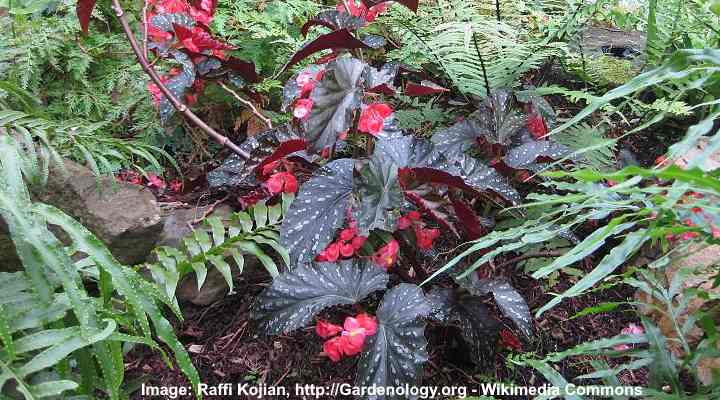
Angel wing begonia propagation is easily done by stem cuttings
Angel wing begonia propagation is best using stem cuttings. First, cut the cane stems just below a node, making sure they are at least 6” (15 cm) long. Remove all the leaves apart from the upper leaves and place them in a jar of water for roots to develop. When the roots grow about 1” (2.5 cm), plant in a loose, moist potting soil.
Alternatively, you can place the cane cuttings directly in potting soil. Gently tugging as the begonia stem after a few weeks will let you know the begonia cutting is rooted.
How to Plant Angel Wing Begonia in the Garden
Angel wing begonias are beautiful foliage flowering plants that thrive in tropical and subtropical climates. You can plant the winged begonias outdoors as long as the temperature never dips below 55°F (13°C).
Here is a handy guide to growing angel wing begonias outdoors:
When to plant angel wing begonia: Wait until the threat of cold has passed before planting the begonias in the ground. The plants are not tolerant of cold, and frost will damage the foliage and roots.
Where to plant angel wing begonia: The best location for angel wing begonias is a partially shaded location or dappled sunlight. Plant the begonias between 1 and 3 ft. (0.3 – 1 m) apart, depending on the spread of the hybrid. In hot, tropical climates, begonia growing outdoors perform best when they get two hours of morning sunshine daily.
How to plant angel wing begonia: Plant angel wing begonias in loamy ground that is well-draining. The rooted begonias should be transferred to the garden when the risk of frost has passed.
Growing Angel Wing Begonias in Containers
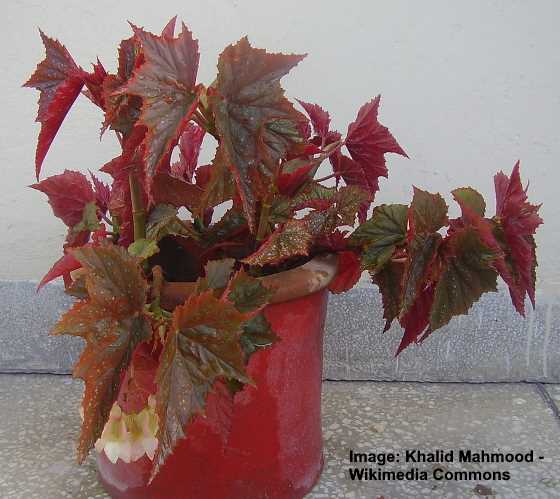
Potted angel wing begonia
Angel wing begonias with their large triangular leaves are easy to grow in containers. The glossy green spotted foliage and red, orange, pink, or white flowers are attractive in container gardens, patios, or deck areas.
To thrive in containers outside, angel wing begonias need to grow in a loose, well-drained potting mix. Ensure the pot has drainage holes and amend the soil mix with organic matter for nutrients and perlite for drainage. Potted outdoor begonias need watering more often than those planted in the ground. Only water the plants when the top layer of soil is dry.
Angel Wing Begonia in Hanging Basket
The angel wing begonia also goes by the name hanging begonia due to its drooping flower clusters and long, arching stems. Masses of pink or red flower clusters cover the hanging plant when in bloom, creating a large group of cascading colors. The hanging basket begonia flowers grow best in dappled sunlight or partial shade.
How to Overwinter Angel Wing Begonias
If you live in USDA zones 9 and lower, it’s crucial to overwinter begonias indoors during the winter. To acclimate the potted begonias, bring them indoors during the night and then back outside during the day. After a week, you can keep the angel wing begonia in a sunny spot in your house but out of direct sunlight.
Growing Angel Wing Begonia Indoors

When grown indoors, keep the angel wing begonia in an indirect light
Angel wing begonias are low-maintenance, easy-care houseplants that thrive indoors. Typically, keeping the potted begonia in a bright indirect light, watering the soil when it partially dries, and feeding with a balanced fertilizer ensures lush foliage and plenty of healthy blooms.
Let’s look in more detail at how to grow angel wing houseplants.
Light Requirements for Angel Wing Begonia Houseplants
Angel wing begonias thrive in bright, indirect light, protected from intense direct sunlight. Getting enough sunlight and fertilizer is the best way to ensure the begonia blooms indoors. In their native habitat, Begonia coccinea and Begonia aconitifolia grow in dappled sunlight and produce evergreen foliage throughout the year.
When it comes to sunlight, angel wing begonia hybrids are not as robust as wax begonias. Still, they are not as sensitive to light as rex begonias.
It’s good to remember that angel wing begonias need ideal light conditions indoors to bloom during summer. However, even if you don’t get begonia flowers, the spectacular glossy leaves and bushy foliage makes this an attractive houseplant.
The Best Potting Mix for Angel Wing Begonia Houseplants

Angel wing begonia potting mix should be well-draining yet retain some moisture
Angel wing begonia grows best in a fertile, potting mix that drains well. To create the ideal houseplant soil mix for begonias, combine two parts peat moss, one part compost, one part perlite, and add a tablespoon of limestone. You can also grow begonia houseplants in an African violet commercial mix.
The perfect begonia soil should retain moisture without becoming too soggy or staying waterlogged. Peat moss or coco coir is ideal for houseplant soil moisture retention. Perlite helps to improve drainage, and compost provides nutrients to encourage lush foliage and plenty of flowers.
How to Water Angel Wing Begonia Indoor Plants
Water an angel wing begonia as often enough to keep the soil moist but not soggy. The best way to water the begonia is to wait until the top 1” to 2” (2.5 – 5 cm) of soil is dry. Then thoroughly drench the soil until the water pours out the pot’s drainage holes.
Signs that you need to water an angel wing begonia are when the leaf edges turn brown. Too much water in the soil will cause the roots to rot and make the beautiful leafy foliage wilt. Remember that during winter, you need to water a potted begonia houseplant less frequently.
Temperature Requirement for Indoor Angel Wing Begonia
The ideal temperature range for an angel wing begonia is between 65°F and 75°F (18°C – 24°C). The minimum temperature for this plant is 50°F (10°C), but the foliage could experience damage if it dips below 55°F (12°C). Therefore, average room temperatures are ideal for growing an angel wing houseplant.
When growing angel wing begonias indoors, it’s vital to keep the plants out of cold drafts. For example, air conditioning in the summer or an open window in winter can stress the plant and cause the wing leaves to wilt and die.
Angel Wing Begonia Humidity Needs
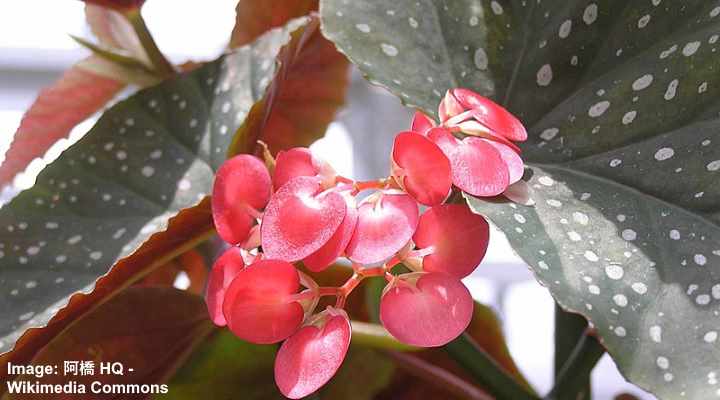
Angel wing begonia needs high humidity and warm temperatures
Angel wing begonia thrives in high humidity and warm temperatures. To achieve ideal growing conditions, sit the leafy houseplant on a pebble tray that is half-filled with water. Alternatively, you could group your tropical plants to grow together. Or a room humidifier could keep relative humidity above 50 percent.
Should you mist angel plant begonia’s leaves? Some people suggest misting the triangular begonia leaves daily helps increase humidity. However, this is only a short-term solution if room air moisture levels are too low and the leaves develop brown tips. Additionally, too much dampness on the leaves could cause fungal diseases and powdery mildew.
How to Fertilize Angel Wing Begonia in Pots
Angel wing begonia benefits from regular fertilization because it’s a heavy bloomer. Apply a houseplant fertilizer diluted to one-quarter strength every week. If you want to encourage vibrant flower and foliage colors, you could dilute the fertilizer to half-strength. A high-phosphorus fertilizer with an NPK rating of 5-10-5 encourages blooming.
Repotting Angel Wing Begonia
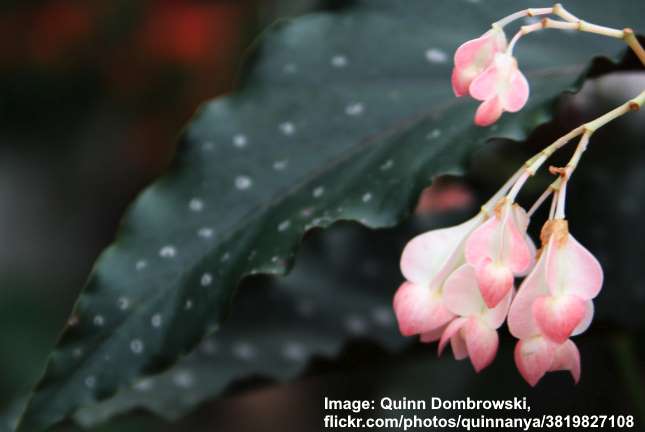
Angel wing begonia performs better when slightly root-bound
Angel wing begonia houseplants tend to grow better when slightly root-bound. You can repot the begonia plant once every two years to give the roots room to grow, refresh the potting soil, and check for signs of root damage. The best time to repot the plant is in early spring, when growth is vigorous.
When choosing a suitable pot to repot a begonia, choose one that is one size larger than its current one. Also, a terracotta pot is the best choice of pot as it provides the large houseplant stability. It also allows excess moisture to evaporate from the soil faster.
Pests and Diseases Affecting Angel Wing Begonia Growth
Angel wing begonia houseplants are susceptible to aphids and spider mites. The signs of an aphid infestation are small flies crawling underneath foliage or flying around your plants. You can spot spider mites by looking for web-like thread hanging from stems and leaves. The spider-like mites can be red or black tiny pests.
Use a neem oil spray to get rid of houseplant pests. Mix 2 tsp. neem oil, 1 tsp. liquid Castile soap, and 1 quart (1 l) of water in a spray bottle. Shake to combine the ingredients. Thoroughly douse foliage once a week to get rid of plant bugs and mites. Continue applying the neem oil until all signs of pests are gone for good.
Root rot can easily affect cane begonias if you water them too often or the soil has poor drainage. If you notice that the canes are soft, it’s vital to repot the plant in fresh potting soil, remove dead roots, and water your houseplant appropriately in the future.
Is Angel Wing Cane Begonia Toxic?
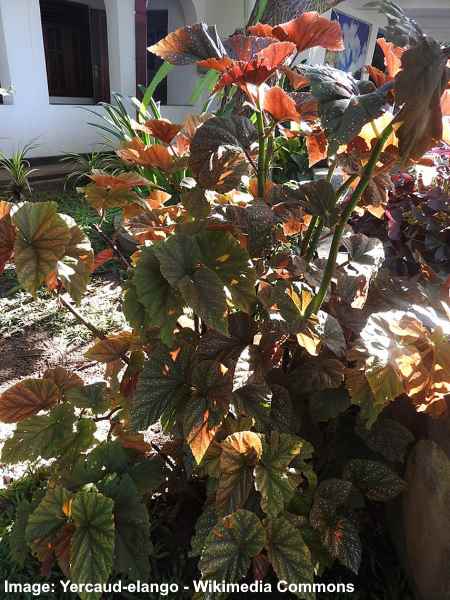
Angel wing begonia is toxic for dogs and cats
Angel wing begonia and other plants in the family Begoniaceae are poisonous to cats and dogs. The ASPCA says that ingesting parts of begonia stems, leaves, or roots can cause vomiting and excessive drooling in dogs and cats.
How to Get Angel Wing Begonia to Bloom Indoors
Angel wing begonias bloom indoors under ideal conditions. To maximize chances of angel wing begonia blooming, ensure the tropical plant grows in bright, indirect light and warm temperatures with enough humidity. Only water the angel wing begonia plant when the soil partially dries. You can also apply a diluted high-phosphorus fertilizer to encourage the begonia houseplant to bloom.
Related articles:
- Wax Begonia: Flower, Leaves – Plant Care Guide
- Begonia Maculata Care: How to Grow Polka Dot Begonia (Wightii)
- Beautiful Red Leaf Houseplants
